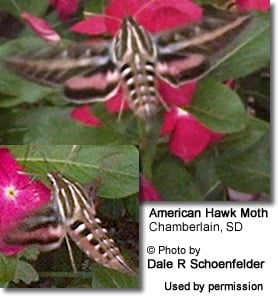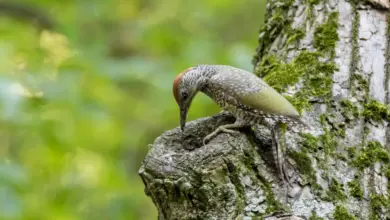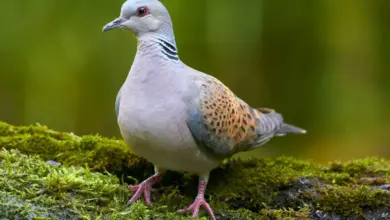Hummingbirds found in Ohio, USA
Hummingbirds found in the USA (by U.S. State) … Canada … Mexico … Puerto Rico … Jamaica … Honduras
Hummingbird Information … Hummingbird Species Photo Gallery
Following listed (with photos) are hummingbirds found in Ohio:
Ruby-throated Hummingbird (Archilochus colubris) – Native – Usually arrive in late April, early May – with males usually being the first to show up to stake out their feeding territories. Most leave toward the end of September. Males usually depart first, and females and juveniles follow about two weeks later.
The male has a ruby-red throat, a white collar, an emerald green back and a forked tail.
The female has a green back and tail feathers that are banded white, black and grey-green.
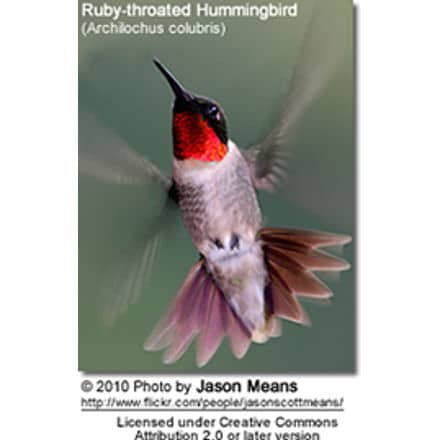
Rufous Hummingbirds (Selasphorus rufus) – … Like the Ruby-throated Hummingbirds, they usually arrive in the first week of May, with males usually being the first to show up to stake out their feeding territories. Most leave toward the end of September. Males usually depart first, and females and the young follow about two weeks later.
Males can easily be identified by their glossy orange-red throats.
Females have whitish, speckled throats, green backs and crowns, and rufous, white-tipped tail feathers.

Rufous Hummingbird versus the similar Ruby-throated Hummingbird (Identification)
Broad-tailed Hummingbirds (Selasphorus platycercus) – Rare
Males can most easily be identified by their iridescent, rose-red throats, white chest feathers and metallic green back and crown and their rounded tails. The males’ tails make whistling noises in flight.
Females lack the flashy throat patch of the male and are mostly pale below. Their white-tipped outer tail feathers are rust-colored close to the body and blackish in the center; the tail feathers in the center range from green to blackish.

Anna’s Hummingbirds, Calypte anna – Rare / Accidental Visitors
One of the larger and the most vocal hummingbirds in the United States, where it is the only species to produce a song; specifically the males produce a complex series of scratchy noises, sounding like a sharp “chee-chee-chee; when moving from flower to flower, they emit toneless “chip” vocalizations. All other hummingbirds in the United States are mostly silent.
They are well known for their territorial behavior; the male makes elaborate dive displays at other birds and sometimes even at people. At the bottom of their dives, they produce high-pitched loud popping sounds with their tail feathers.
Males have glossy dark rose-red throats and crowns, which may appear black or dark purple in low light. The underside is mostly greyish; and the back metallic green.
Females have light grey chests with white and red spotting on the throat, greenish back and white tipped tails.
They resemble the Costa’s Hummingbirds, but the male’s Costa’s Hummingbird’s gorget (throat feathers) is longer than that of the Anna’s. They are larger than the Rufous Hummingbirds and lack the rusty coloration of the Rufous Hummingbirds.


Calliope Hummingbirds (Stellula calliope formerly Archilochus calliope) – Rare / Accidental visitors.
The smallest breeding bird in North America. They are most easily confused with the Rufous Hummingbirds and the Broad-tailed Hummingbird.
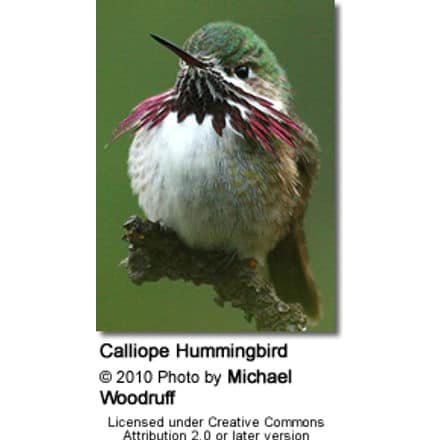
Please note: The Hawk Moth is easily confused with a hummingbird, as they have similar feeding and swift flight patterns. These moths also hover in midair while they feed on nectar.
Moths have a couple of sensors or “antennas” on top of the head, which are key identifiers.
If you see a bird that doesn’t appear to be any of the above, please e-mail comments / images to: [email protected]. Thanks!
Their favorite feeding plants are:
Shrubs / Trees / Vines
- Cardinal climber
- Scarlet trumpet vine
- Northern catalpa
- Morning glory
- Brown’s honeysuckle
- Fly honeysuckle
- Cape honeysuckle
- Coral honeysuckle
- Cypress vine
- Morning glory
- Scarlet runner bean
- Trumpet creeper
- Beauty Bush
- Old–fashioned weigela (Bristol Red, Red Prince)
- Flame acanthus
- Flowering quince
- Lantana
- Manzanita
- Mimosa
- Red buckeye
- Tree tobacco
- Turk’s cap
- Weigelia
- New Jersey tea
- Cockspur hawthorn
- Washington hawthorn
- Apples and crabapples
- Rhododendrons
- Azaleas
- Shadbush
- Flowering cherry trees
- Virginbower
- Tuliptree
- Flowering quince
- Horse chestnut
- Hybrid clematis
- Butterfly bush
- Rose of Sharon
- Lilacs
Annuals
- Nasturtium: Prefers full sun, but will also grow in partial shade
- Salvia: Anise Sage (Salvia guaranitica) – blue flowers. One of hummingbird favorites. Also: Salvia pensetmonoides and Texas Sage (Salvia coccinea), Salvia ‘Maraschino’ (Bush Salvia)
- Shrimp plant
- Geranium
- Pincushion flower
- Beard tongue
- Fire spike
- Fuchsia
- Impatiens
- Jacobiana
- Jewelweed
- Petunia
- French marigold
- Mexican sunflower
- Flame flower
- Common portulaca
- Zinnia
Biennials / Perennials
- Cardinal Flowers (Lobelia cardinalis)…beautiful native perennial. Great in beds, bogs and containers
- Purple coneflowers (for insects)
- Penstemon (penstemon digitalis)
- Royal catchfly (silene regia)
- Japanese bleeding heart
- Bee balm, Oswego tea
- Blue Fortune agastache (hardy from Zones 4-10)
- Dahlia
- Bee balm (Monarda)
- Canna
- Coral bells
- Four o’clock
- Hosta
- Hummingbird mint – (Agastache cana and Agastache rupestris / Agastache ‘Acupulco Salmon and Pink’ ) – Perennial; grows quickly; very fragrant.
- Little cigar
- Lupine
- Penstemon barbatus
- Yucca
- Impatiens
- Sweet William
- Canna Lily
- Butterflyweed
- Bluebells
- Fuschia
- Four O’clock
- Showy evening primrose
- Virginia creeper
- Cup plant
- Bugleweed
- Globe thistle
- Maltese cross
- Hollyhock
- Wild or Canada columbine; European columbine
- Delphinium
- Foxglove
- Fireweed
- Dwarf blue gentian
- Gladiolus (red colors)
- Daylily
- Coral bells
- Hosta
- Blazing Star
- Turk’s cap lily
- Wood lily
- Wild bergamot
- Moss Pink
- Wild Blue Phlox
- Phlox

